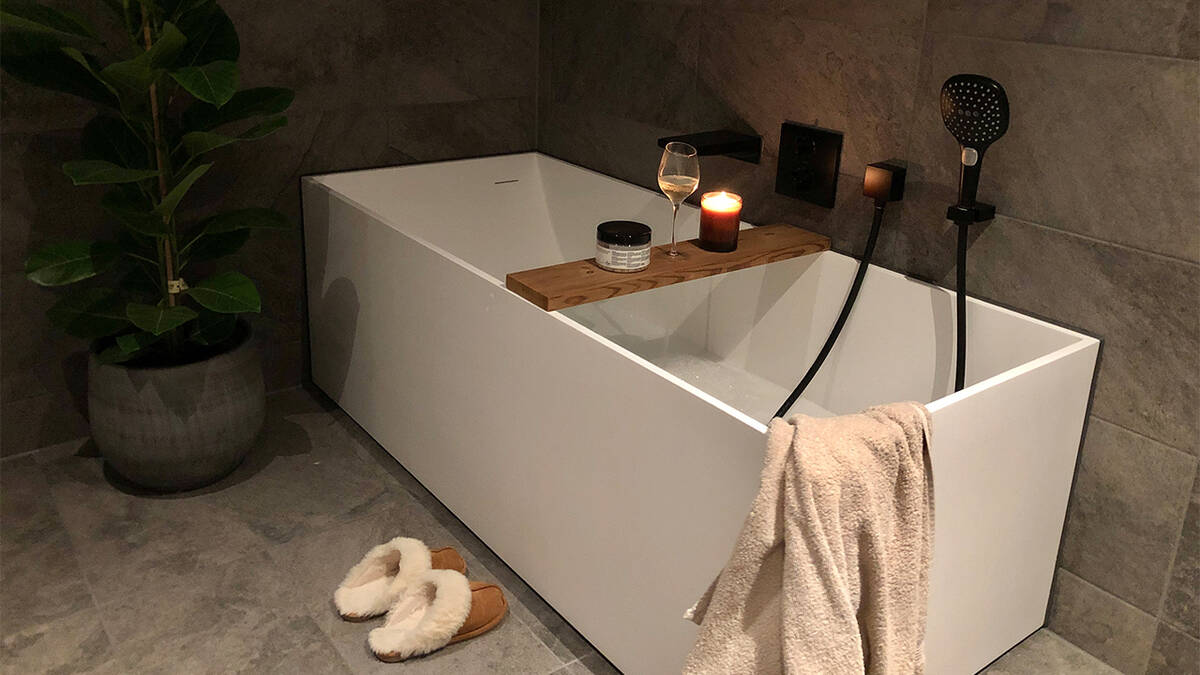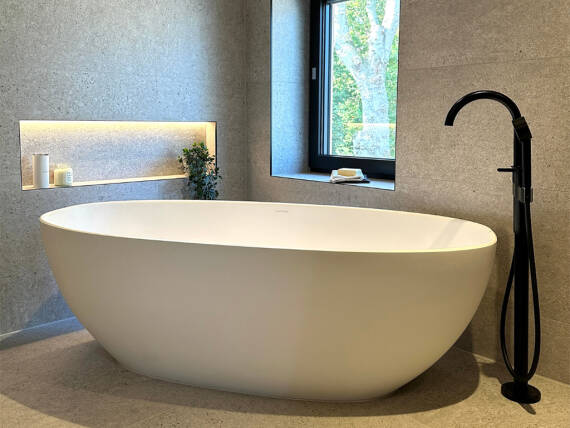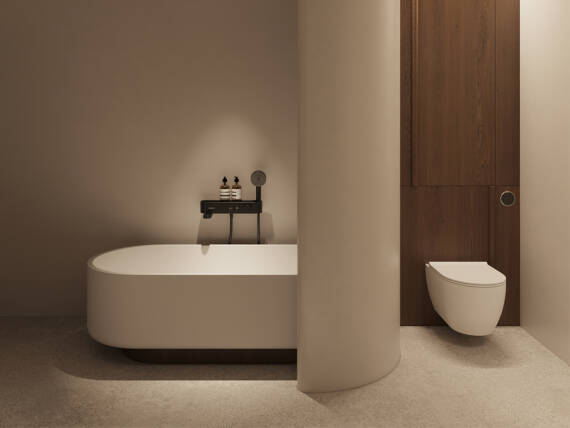Bath tub: reduce CO2 emissions
Bath tub water consumption: How to reduce your ecological footprint
It's well-known that regular, hot baths can significantly increase our carbon footprint. A full bath consumes twice to five times as much water and energy as a shower, which is detrimental to the environment or our utility bills. If you're thinking, "But I love baths! I'll just cut costs elsewhere and balance my CO2 emissions by cycling," that's perfectly understandable; after all, unwinding and escaping stress is crucial. That's why hansgrohe offers a solution to help you enjoy your baths with a clearer conscience.
Do away with the bath tub altogether and just take a shower?
As a leader in wellness, hansgrohe designs products that aim to delight everyone. Additionally, we conduct our own research because all of our innovations consider the environment. For instance, hansgrohe has carried out a CO2 analysis to assess the ecological footprint in the bathroom, revealing significant savings in the bathtub. In short, both your little mermaids and rubber duck captains can rest easy before diving in.

How many liters fit in a bath tub?
An average bathtub can hold between 100 to 200 litres of water, while larger tubs may use significantly more. It's important to consider that each litre of water also requires heating, which consumes energy. In comparison, showering typically uses between 40 to 60 liters, offering a substantial saving in water, energy, greenhouse gas emissions, and costs. Therefore, opting for a shower over a bath can have a positive impact on your CO2 footprint.
Reduce water consumption in the bath tub - tip 1: shower instead of bathing

Wellness showers are a game-changer, offering a spa-like retreat with multiple shower heads and wellness jets that rival a luxurious bath. Opting for showers equipped with an eco function and microfine PowderRain jets not only delights with cost savings but also enhances the experience. Consider a walk-in shower, free of tripping hazards, as a smart investment for a secure and comfortable future.
Do you want to calculate your potential CO2 savings in the bathroom?
Products designed with the environment in mind, such as those featuring EcoSmart technology, use significantly fewer resources without compromising on comfort. Whether you're bathing, showering, or simply washing your hands, you can quickly find out your water and energy savings with the hansgrohe water savings calculator for taps and showers.
Conserving resources and saving in the bath tub (usage phase)
The hansgrohe CO2 analysis distinguishes between "use phase" (= CO2e emissions during the use of a bathroom product) and "creation phase" (= CO2e emissions during the manufacture of a bathroom product). Here are the specific figures for the usage phase in your household:
- The Water requirement in the bath tub causes CO2e emissions of 40 kg CO2e (per complete service life of 20 years in a 4-person household)*.
- The Energy requirement for hot water in the bath tub generates 2,460 kg CO2e (per complete service life of 20 years in a 4-person household).
The results show: For you, the biggest lever for saving greenhouse gases at the bath tub is hot water, and by a wide margin. We have many opportunities to reduce our demand for hot baths and cut our costs;
*The calculations are based on a standard bathtub in a German bathroom:
Reduce water consumption in the bath tub – Tip 2: bathe less often and less hot
- Make the full bath a luxurious exception to your bathing routine, and not quite so often.
- Reduce your CO2 footprint by not as hot as usual.
- Consume fewer resources by not filling the bath tub. Keyword: half filling or sitz bath.
Unlike basin taps, the flow rate (= water consumption of liters per minute) is not as important for bath mixers. After all, you want the bath tub to fill as quickly as possible for a full or half bath.

Do you shower in your bath tub?
Perhaps you are among the many who have a shower over the bath rather than a shower cabin. Here, intelligent water and energy-saving technologies are crucial. Showers equipped with EcoSmart technology significantly reduce water consumption, thanks to a key feature: the "flow limiter". The less water that needs heating, the lower the CO2 footprint and the energy bill.
- Please also read our magazine article on CO2:Take a more climate-friendly shower!
Reduce your CO2 footprint with smart purchasing decisions (creation phase)
In addition to conserving resources, we can further reduce our carbon footprint in the bathroom by making wise purchasing desicions. It is crucial to invest in high-quality bathroom products from reputable manufacturers. Often, a bath mixer or an inexpensive shower head from a discount store will fail quickly. These short-lived products not only drain our wallets but also have a significant environmental impact due to frequent replacements. There is another trick to saving CO2 when it comes to your beloved bath:
Reduce water consumption in the bath tub – Tip 3: have a small bath tub installed
Bathtubs that rival the size of swimming pools may seem luxurious, but they carry the environmental footprint of a Goliath. We should aim to be Davids, forgoing such excess in the name of responsibility for the environment and future generations. The reality is, each litre of hot water consumed not only ticks the meter but also contributes to greenhouse gas emissions. If you're in the process of rethinking and renovating your bathroom, consider this:
- Take a standard tub or even better:a space-saving tray with a smaller filling volume.
Tip 4: Buy a bath tub made of non-perishable material
Materials, packaging, and recyclability are crucial ecological considerations for bathroom furnishings. Aim to create products of timeless quality that boast longevity and can be easily recycled eventually. Materials such as recyclable steel enamel or high-quality, durable acrylic come highly recommended.
- The CO2 analysis by hansgrohe puts the CO2 consumption of a bath tub made of sanitary acrylic in the construction phase at 101 kg CO2e by comparison.
Tip 5: Choose sustainable products for your bath tub
The same standards that apply to the bathtub should extend to everything you install around it: avoid low-quality plastic with limited durability. Instead, choose bathroom products that boast a robust life cycle assessment and are supplied by companies dedicated to sustainable value chains and the principles of a circular economy. When making a purchase, be vigilant for environmental seals, eco-certificates, and test stickers. In summary, to reduce your CO2e footprint in the bathroom, make eco-conscious choices regarding bath materials, mixers (whether concealed or exposed), wall coverings, tiles, hand showers, shower hoses, and hose connections. Ensure that accessories and storage systems for the bathtub are also of high, lasting quality.
- You will find plenty of inspiration for bathroom planning, in which climate-friendly products are used.
- Here come more water saving tips for the bathroom.
Frequently asked questions about saving CO2 in the bath tub
Yes, you use an average of 40 to 60 liters in the shower and an average of 100 to 200 liters in a full bath in a standard bath tub. So you save a lot of water, energy, greenhouse gases and costs when you shower. You save the most with water-saving showers.
If you buy a shower system with several showers and wellness jets, you can enjoy a time-out for body, mind and soul comparable to a full bath. And yes: hansgrohe eco showers can be used with microfine PowderRain, for example. You can look forward to the savings potential and the feel-good factor.
Bathe less often and make a full bath a luxurious exception to your bathing routine. If you do take a full bath, don't bathe quite so hot. And simply don't let the bath tub fill to the brim, this also reduces your ecological footprint.
With bath mixers from discount stores, there is a risk that their quality and durability will not be convincing. Cheaper models often tend to wear out prematurely, which can make it necessary to replace them soon. Worn products pollute the environment and cause unnecessary waste. Make sure you buy durable bathroom products from a brand manufacturer or have them installed.
When buying a bath tub, material, recyclability and durability are essential ecological criteria. It is advisable to opt for timeless quality products that offer a long service life and can be easily recycled at the end of their life cycle. For bath tubs, materials such as recyclable steel enamel and high-quality, durable acrylic are preferable.
Trusted partners